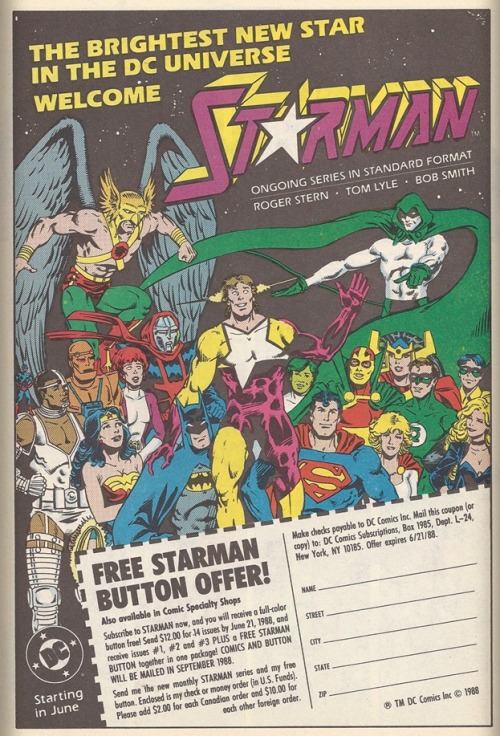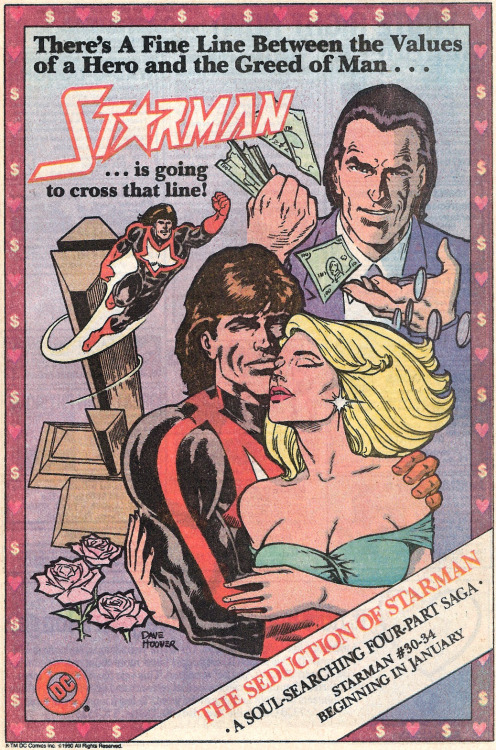Starman Starman was created by Roger Stern (writer) and Tom Lyle (penciler). Stern had been wr
Starman Starman was created by Roger Stern (writer) and Tom Lyle (penciler). Stern had been writing for Marvel Comics since 1975, and had just finished a lengthy run on Marvel’s Avengers before free-lancing for DC comics and creating this new Starman series. In 1987, DC comics had three other ‘Starmen’ in its continuity: the golden age Justice Society of America Starman, a blue-skinned Starman who appeared in a 1976 one-shot, and an alien Starman who appeared in Adventure Comics (1980) for a brief period. This new Starman created by Stern and Lyle, also knows as the 'Will Payton Starman’ by fans, had no relation to any of them. This new Starman was created for several reasons: 1) DC needed new third generation characters for it’s younger fans, 2) good names were hard to come by (the previously mentioned Starmen were in comic book limbo at the time), 3) DC had successfully reintroduced old names in new forms (see: Silver Age Flash, Silver Age Green Lantern, Silver Age Atom, etc…) and 4) DC reasoned that creating a character to help ease readers into the new company-wide crossover (INVASION!) would be a good cross-promotional strategy. As far as Starman’s powers went, he was a pretty run-of-the-mill character: power of flight, super strength, ability to shoot blasts of power from his hands and invulnerability. Fans complained he was too similar to Marvel’s Starbrand or DC’s Captain Atom. Will Payton was also given the powers of having a malleable face and the ability to shine really bright (like a star). What really set Starman apart, however, was how the series was written. Stern really played up the “ordinary Joe learning the ropes of being a superhero” angle of the series, depicting Will Payton as a man who has suddenly gained powers and is trying to do 'the right thing’ (this was a refreshing change from all of the anti-heroes that were suddenly running around all over comicdom). Strong emphasis is placed on Starman’s supporting cast (his sister, his mother, etc) and his relationships with the regular people around him. As a matter of fact, the issue that got the most fan mail was a storyline in which Starman confronts his dying father who abandoned his family when he was younger. So, needless to say, it was Stern’s fine attention to characterization that really held favor with the fans. Stern also created the DC super-villain Deadline, who first debuted in this series. A post-Crisis Dr. Polaris and a new Blockbuster were also introduced in this series.Stern was very adamant about not having Starman join any super-teams (ex: Justice League) until his character was more established, much to the chagrin of fans. I get the feeling that Stern really liked writing this character and had a lot of great ideas, but for whatever reason could not always follow-through due to other ideas from the DC editorial board (ex: cross-over tie-ins and etc). Guest-stars appeared occasionally (Batman, Superman, Power Girl, Firestorm, etc) but Stern managed to keep them sporadic so it didn’t become a 'team-up’ series. Lyle left after issue #25 to work on other projects, and in issue #26 Starman received a new regular penciler and a new costume (both of which fans were not pleased with). It should be noted that Stern and Lyle wrote and pencilled the first 25 issues of the series without any fill-ins. That’s pretty monumental.Starman’s star fell after issue #28, when Stern left the series for a new project and Len Strazewski took over writing chores. I’m not saying Strazewski’s stroy lines were bad per se, it just seemed like his new direction for Starman was not what fans were looking for. Gone were Starman’s supporting cast, soul-searching and subplots, instead we now had super-hero slugfests. Of course there is one exception, and that would be Strazewski’s 'Seduction of Starman’ storyline (Starman #30 - #33) in which Strazewski creates the Star Fund in the letter column of Starman #33 in an effort to help promote local charities and encouraging readers to donate. By mid-series Starman’s sales were not very exceptional, but by issue #31 select comic book shops had stopped ordering the title altogether, speculating the title would be cancelled soon. Paul Kupperberg took over as editor in issue #38 (formers editors included Katie Main, Brian Augustyn and Robert Greenberger) but that wasn’t enough to re-ignite sales. The final nail in the coffin was when Lobo made a guest appearance in issues #42 - 44 (at this point, it was pretty much decreed that if Lobo was guest-starring in your series it was pretty much to help boost dwindling sales). Starman #45 was the last issue in the series. I just wanted to mention that issues #42 - #45 featured some beautiful Mike Mignola (of Hellboy) covers.The Will Payton Starman is killed off during DC’s 1992 Eclipso: The Darkness Within company-wide cross-over.This Starman series basically flew under the radar for me until I read James Robinson’s excellent excellent 1994 Starman series. After reading the 1994 Starman series I had to track down every Starman comic I could get my hands on. The first 25 issues of the 1988 Starman series are seriously great stuff, for the aforementioned reasons in paragraph 3. I don’t know the circumstances in which Lyle or Stern left - maybe they had no more Starman stories left to tell? - but I don’t think the Will Payton Starman was played out to his full potential by DC. One of the reasons this series didn’t sell so well was due to lack of promotion and advertising - other than that nifty pin you get when subscribing (as seen in the ad above), the whole Starman marketing campaign was heavily reliant on word-of-mouth. Of all the other new characters that cropped up after Crisis On Infinite Earths (ex: Wild Dog, Manhunter, Booster Gold, Jonni Tunder, etc), Starman had a really nice run of 45 issues that lasted into the early 90s - which is actually quite impressive.AddendumIn his February 17, 2016 interview with Aaron Head on the Task Force X podcast, Kupperberg reveals that 1996’s Takion series was originally pitched as a 'return of Will Payton Starman’ series - the general premise being that Will Payton returns from comic book obscurity as a newer, more powerful Starman. The idea was scrapped when both editor Dan Thorsland and Kupperberg discovered that the Robinson Starman series was in the works (which may or may not have had plans of Will Payton), and the character of Will Payton Starman was promptly replaced with Takion - a Jack Kirby Fourth World 'spin-off’ character. -- source link
Tumblr Blog : dcinthe80s.tumblr.com
#starman#wil payton#invasion#stern#fourth world#kupperberg

